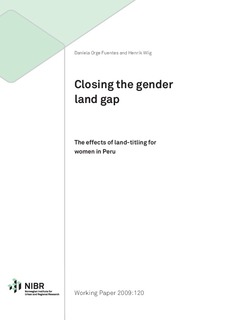| dc.contributor.author | henwii | |
| dc.contributor.author | Daniela Fuentes | |
| dc.date.accessioned | 2019-08-15T07:41:59Z | |
| dc.date.accessioned | 2021-04-29T13:53:21Z | |
| dc.date.available | 2019-08-15T07:41:59Z | |
| dc.date.available | 2021-04-29T13:53:21Z | |
| dc.date.issued | 2009 | |
| dc.identifier.isbn | 978-82-7071-816-0 | |
| dc.identifier.issn | 0801-1702 | |
| dc.identifier.uri | https://hdl.handle.net/20.500.12199/2532 | |
| dc.description.abstract | Last ned gratis Formalization of land ownership in developing countries tends to cement gender inequalities. In Peru we find the opposite: A large scale survey show 43 % joint ownership for titlede land compare to 39 % for untitled plots.However, it is more than three times higher than the 13 % joint ownership in a similar survey from 2000. Gender equality might have become even more pronounced as joint ownership increases to 56% for the subsample of titled male-headed couple household. Tilknyttet prosjekt How formalization closed the gender gap in Peru and the impact on women's empowerment | no_NB |
| dc.publisher | Oslo: Norsk institutt for by- og regionforskning | |
| dc.relation.ispartofseries | NIBR-notat 2009:120 | |
| dc.subject | NIBR, PublikasjonerNIBR, Notat_NIBR | |
| dc.title | Closing the gender land gap | no_NB |
| dc.type | Notat | |
